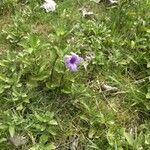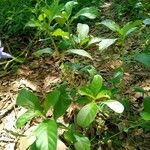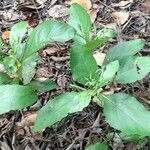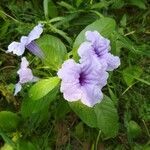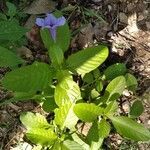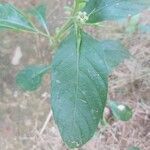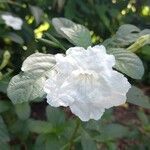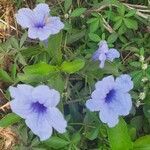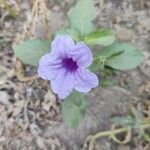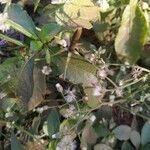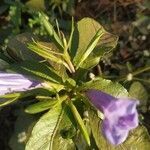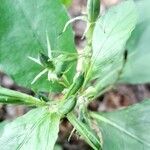Herbs to 45 cm tall, perennial, erect. Roots with elongate tuberlike swellings. Stems slightly swollen above nodes, almost 4-angled, strigulose on angles. Petiole to 8 mm, glabrous; leaf blade oblong-obovate, 4-8 × 1.5-4.2 cm, both surfaces glabrous, veins abaxially somewhat prominent, base cuneate and tapering onto petiole, margin undulate to subentire, apex acute. Inflorescences axillary, lax dichotomous cymes; peduncle to 2.3 cm; bracts oblong-lanceolate, to 3-9 × 1-3 mm; bracteoles linear-oblong, to 1.5 mm. Pedicel 6-10 mm, minutely pilose. Calyx tube to 6 mm, outside tomentose; lobes linear-lanceolate, 0.9-2 cm. Corolla pale blue, 2.2-5.5 cm, outside hirtellous; lobes suborbicular, ca. 1.6 × 1.5 cm. Stamens with longer pair ca. 8 mm and shorter pair ca. 4 mm; filaments glabrous; anther thecae white, hairy on dorsal side. Ovary glabrous except for a few gland-tipped trichomes at apex; style ca. 2.1 cm, sparsely hirsute; stigma 2-lamellate. Capsule not stipitate, linear-ellipsoid, 1.8-2.5 × 0.3-0.4 cm, glabrous except for a few gland-tipped trichomes at apex, 20-26-seeded; septa with attached retinacula remaining attached to inner wall of mature capsule. Seeds discoid, ca. 2 × 2 mm, covered with appressed hygroscopic trichomes. Fl. Dec-Jan, fr. May-Jul. 2n = 32, 34.
A herb. It can be upright or lie over. It is about 30 cm high. The roots are long and fleshy. It has 1 or 2 main branches. They are 4 angled. The leaves are 4-8 cm long by 2-4 cm wide. The flowers are in the axils of leaves. The flowers are blue and purple. The fruit is a cylinder shaped capsule 17-24 mm long and 3 mm wide. It explodes on contact with water. There are 20-26 seeds. These are 2-2.5 mm wide.
